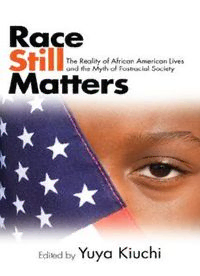
Race Still Matters: The Reality of African American Lives and the Myth of Postracial Society PDF
Preview Race Still Matters: The Reality of African American Lives and the Myth of Postracial Society
Race Still Matters SUNY series in African American Studies John R. Howard and Robert C. Smith, editors Race Still Matters The Reality of African American Lives and the Myth of Postracial Society Edited by Yuya Kiuchi Published by State University of New York Press, Albany © 2016 State University of New York All rights reserved Printed in the United States of America No part of this book may be used or reproduced in any manner whatsoever with- out written permission. No part of this book may be stored in a retrieval system or transmitted in any form or by any means including electronic, electrostatic, magnetic tape, mechanical, photocopying, recording, or otherwise without the prior permission in writing of the publisher. For information, contact State University of New York Press, Albany, NY www.sunypress.edu Production, Ryan Morris Marketing, Kate R. Seburyamo Library of Congress Cataloging-in-Publication Data Names: Kiuchi, Yuya, editor of compilation. Title: Race still matters : the reality of African American lives and the myth of postracial society / edited by Yuya Kiuchi. Other titles: Reality of African American lives and the myth of postracial society Description: Albany : State University of New York Press, [2016] | Series: SUNY series in African American studies | Includes bibliographical references and index. Identifers: LCCN 2016007296 (print) | LCCN 2016028131 (ebook) ISBN 9781438462738 (hardcover : alk. paper) ISBN 9781438462721 (pbk : alk. paper) ISBN 9781438462745 (e-book) Subjects: LCSH: African Americans—Social conditions—21st century. | African Americans—Race identity. | Race discrimination—United States. | Racism—United States. | United States—Race relations—21st century. Classifcation: LCC E185.86 .R245 2016 (print) | LCC E185.86 (ebook) | DDC 305.896/073—dc23 LC record available at https://lccn.loc.gov/2016007296 10 9 8 7 6 5 4 3 2 1 To Nicki Contents Preface ix Acknowledgments xv Introduction xvi Part 1: Race 1: Reverse Racism: A Discursive History 3 Tad Suiter 2: “The Struggle is Real out Here”: The Contextual Reality 41 of Being Black Couples and Families in America Karlin J. Tichenor 3: Holy Smoke: Church Burnings, Journalism, and 71 the Politics of Race, 1996–2006 Christopher Strain 4: Fear of a Black President: Conspiracy Theory 101 and Racial Paranoia in Obamerica Travis L. Gosa and Danielle Porter Sanchez Part 2 : Structural Inequal ity 5: From Orchards to Silicon Valley: African American 133 Suburbanization in the U.S. West, the Black San Jose Model, 1945–2010 Herb Ruffn II 6: African American Economic Experiences: 163 Income, Occupations, Savings, Investments, and Social Security Trends since 2000 LaToya T. Brackett 7: Confronting an Enduring Legacy: 193 Health-Care Workforce Disparity Costellia H. Talley and Henry C. Talley vii viii Contents Part 3 : African American Youth 8: Sustained Inequality: African American 227 Education in a “Postracial” Nation Daniel R. Davis 9: “Nothing We Could Do or Say”: 255 African American Young Men’s Lived Police Experiences Rod K. Brunson and Amanda D’Souza 10: African American Youth and the 275 Postracial Societal Myth Carl S. Taylor and Pamela R. Smith Part 4 : Popular Culture 11: Leave the Prejudice, Take the Power: 301 Crash, Fruitvale Station, and Race in Hollywood in the Twenty-First Century Justin Gomer 12: African American Female Athletic Image: 321 What We Should Take Away from the London 2012 Olympic Games Rachel L. Myers 13: An Obama Effect? African American 343 Voting Behavior and the Political Symbolism of a Black President David C. Wilson, Samantha S. Kelley, Emmanuel Balogun, Christian Solar, and Sahar Salehi Contributors 369 Index 37 Preface Americans agree that slavery was racist. So were Jim Crow laws, residential segregation in the early to mid-twentieth century, and disenfranchisement of Blacks. Americans across the color line also agree that the civil rights movement in the 1950s and ’60s dramatically changed racial politics in the United States. Suppos- edly, employers are not allowed to make hiring decisions based on race. Car dealers should treat white and Black customers equally. The police should not stop a driver just because he or she is Black. White students and Black students should have equal access to high-quality educational resources, including facilities, equipment, and teachers. The reality is far from what these promises seem to suggest. In the nation of collective amnesia and color-blind idealism, many Americans choose to believe that their nation has finally become a City upon a Hill. Choosing to believe in this postracial idealism has pragmatic values. It legitimizes American dreams. Many Americans idolize the idea of the self-made person. If you work hard enough, you can attain anything. If race mattered and racism existed, such a promise is nothing but a mirage. But if one rejects the presence of racism and believes that postracialism has realized in the United States, one can truly claim that the United States is the land of opportunities where anyone regardless of his or her race can be the next Horatio Alger. Believing in the postracial idealism also allows Americans to claim that the country has moved on from its past’s wrongdoings, justifying their diplomatic efforts to bring freedom and equality to the rest of the world. It also offers a sense of superiority and fairness that Americans need as they believe in their assumed role to lead the world economically, politically, and also morally. Especially after the turbulent decade of the 2000s, starting with the terrorist attacks on September11, 2001 and ending with a major economic downturn, the ix
